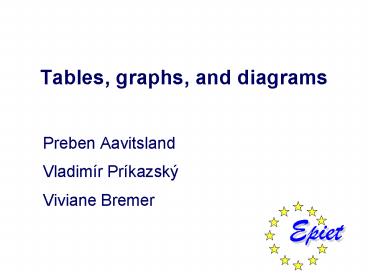Tables, graphs, and diagrams - PowerPoint PPT Presentation
1 / 46
Title:
Tables, graphs, and diagrams
Description:
data from outbreaks, surveillance and studies. Uses of tables, ... Paella. 13.2 (5.3-33.0) 54. 20. 34. Swordfish. OR (CI95%) Total n=124. Controls. n=82. Cases ... – PowerPoint PPT presentation
Number of Views:52
Avg rating:3.0/5.0
Title: Tables, graphs, and diagrams
1
Tables, graphs, and diagrams
- Preben Aavitsland
- Vladimír Príkazský
- Viviane Bremer
2
Tables, graphs and diagrams.
- organise
- summarise
- display
- ...data from outbreaks, surveillance and studies
3
Uses of tables, graphs and diagrams
- Effective presentation
- to the professionals
- to the public
- Easy interpretation
- Visual examination
- Analysis
4
Paper vs. screen
- Paper
- Time unlimited
- Repetition
- Details
- White, grey and black
- Screen
- Time lt 1 min
- No repetition
- Less details
- Colours possible
5
Tables, graphs, and diagrams
- Self-explanatory
- Simple!
- Title
- what, who, where, when
- Define abbreviations and symbols
- Note data exclusions
- Reference the source
6
Type of variables
- Quantitative
- Discrete
- counts, dates, cases,...
- Continous
- height, Hb, .
7
Type of variables
- Qualitative
- Dichotomous
- sex, ill/not ill, .
- Nominal
- religion, nationality, eye colour,...
- Ordinal
- social class, cancer stage, .
8
Tables
9
Types of commonly used tables
- One-variable tables
- Frequency distribution
- Multivariable tables
- Contingency tables
- 2x2 tables
10
(No Transcript)
11
Tab 6. Distribution of cases of salmonellosis
(n65) by age group. Hospital A, Dublin, August
2006
12
Table 9. Gonorrhoea by age-group and sex, Norway,
2005
13
Tab. IV Fish consumption and gastro-intestinal
illness among customers at Uncle Mikes Fish
Chips, Berlin, 2005
14
Tab. IV Gastrointestinal illness and fish
consumption among customers at Uncle Mikes Fish
Chips, Berlin, 2005
15
Table from a case control study (paper) Tab. IV
Gastrointestinal illness and fish consumption
among customers at Uncle Mikes Fish Chips,
Berlin, 2005, n124 (2 cases were excluded)
explanation of symbols - we measured, no
case in this category, we cant say that it is
0 . we measured, but we cant calculate the
average of 1 case
16
In tables...
- Labels for rows and columns
- Totals for rows and columns, usually
- Units of measurements
- Max five variables
- Horizontal lines OK, vertical not
17
Graphs Diagrams
18
Types of commonly used graphs
- Line graph
- Arithmetic scale line graph
- Semi-logarithmic scale line graph
- Histogram
- Epidemic curve
19
The arithmetic-scale line graph 1
20
The arithmetic-scale line graph 2
- For time series
- Show actual changes in magnitude
- X-axis time
- Y-axis incidence (or number) of cases
- Start at 0
- Breaks possible, clearly marked
21
The semilogarithmic-scale line graph 1
22
(No Transcript)
23
The semilogaritmic-scale line graph 2
- For time series when
- interested in rate of change
- X-axis time arithmetic
- Y-axis rate (or number) of cases, logarithmic
- Straight slope constant rate of change
- Steep slope constant rapid change
- Parallell lines same rate of change
- Change in slope acceleration ? deceleration of
rate - Start at lowest cycle, e.g. 0.1-1 or 1-10
- No breaks
24
The epidemic curve 1 Cases of salmonellosis
(n65) by date and time of onset of illness.
Hospital A, Dublin, August 2006
25
The epidemic curve 2
- Histogram
- Area proportional to number
- No space between columns
- One population
- X-axis time
- Start before epidemic, continue after
- Interval 1/4 of incubation period
- Y-axis number of cases
- Usually one square one case Easy to make
in Excel
26
(No Transcript)
27
(No Transcript)
28
(No Transcript)
29
(No Transcript)
30
In graphs...
- Labels for axes, scales and legends
- Legends or keys if gt1 variable
- Scale divison, appropriate scale
- Units of measurements in title
- No grid, no numbers
- No 3D
31
Types of commonly used charts
- Charts based on length
- Bar charts(horizontal, vertical, grouped,
stacked) - Charts based on proportion
- Component bar chart
- Pie chart
32
Grouped bar chart
33
Stacked bar chart
34
Component bar chart
35
Bar charts
- Order
- Natural
- Decreasing or increasing
- Vertical or horizontal
- Same width of bars
- Length frequency
- Space between bars and groups, but not within
groups - Tables are often better
36
Pie chart
37
The area dot (or dot density) map
Figure 2. Cases of meningococcal disease in
Dublin 2006 by area of residence. 1 dot 1 case
38
The spot map
Figure 1. Cases of meningococcal disease in
Dublin 2006 by place of residence. 1 dot 1 case
39
The area map
Figure 3. Incidence per 100,000 of meningococcal
disease in Dublin 2006 by area of residence.
40
Think data-ink
- Every bit of ink should have a reason
41
Designing graphics
- Show the data
- Use ink for the data
- Remove unnecessary ink
- Remove gimmicks
- No 3D
- Careful with colours
42
(No Transcript)
43
(No Transcript)
44
(No Transcript)
45
(No Transcript)
46
Summary
- Use graphics to explore and present data
- Think of difference between paper and screen
- Think of your message and choose the graph type
accordingly - Save your ink!







![Construction and Interpretation of Simple Diagrams and Graphs [I] PowerPoint PPT Presentation](https://s3.amazonaws.com/images.powershow.com/7658618.th0.jpg?_=20160307021)























